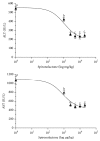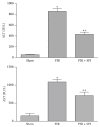Spironolactone Effect in Hepatic Ischemia/Reperfusion Injury in Wistar Rats
- PMID: 26798418
- PMCID: PMC4700188
- DOI: 10.1155/2016/3196431
Spironolactone Effect in Hepatic Ischemia/Reperfusion Injury in Wistar Rats
Abstract
Introduction: Ischemia/reperfusion (IR) injury, often associated with liver surgery, is an unresolved problem in the clinical practice. Spironolactone is an antagonist of aldosterone that has shown benefits over IR injury in several tissues, but its effects in hepatic IR are unknown.
Objective: To evaluate the effect of spironolactone on IR-induced damage in liver.
Materials and methods: Total hepatic ischemia was induced in rats for 20 min followed by 60 min of reperfusion. Spironolactone was administered and hepatic injury, cytokine production, and oxidative stress were assessed.
Results: After IR, increased transaminases levels and widespread acute inflammatory infiltrate, disorganization of hepatic hemorrhage trabeculae, and presence of apoptotic bodies were observed. Administration of SPI reduced biochemical and histological parameters of liver injury. SPI treatment increased IL-6 levels when compared with IR group but did not modify either IL-1β or TNF-α with respect to IR group. Regarding oxidative stress, increased levels of catalase activity were recorded in IR + SPI group in comparison with group without treatment, whereas MDA levels were similar in IR + SPI and IR groups.
Conclusions: Spironolactone reduced the liver damage induced by IR, and this was associated with an increase in IL-6 production and catalase activity.
Figures






References
MeSH terms
Substances
LinkOut - more resources
Full Text Sources
Other Literature Sources

